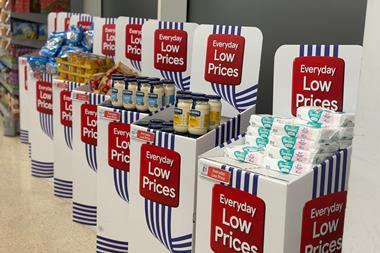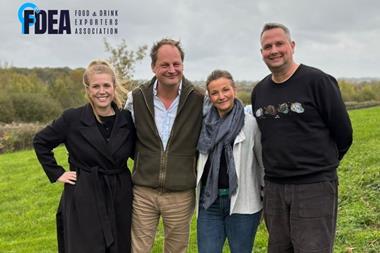Farmhouse Fare’s homeliness is an NPD engine says Stefan Chomka
At a conference in May this year during a question and answer session led by Sir Terry Leahy, Helen Colley stood up and asked the Tesco chief why his supermarket didn’t stock her company’s products while most of the others did. It was a question Sir Terry took seriously, as five months later two of the products gained listings in 350 stores.
As MD of premium pudding company Farmhouse Fare, Colley is used to getting what she wants. Getting her products, which include sticky toffee pudding, sticky syrup pudding and brioche bread and butter pudding, in front of the Booths buyer took a barrage of phone calls until the secretary got fed up and arranged an appointment.
“I’ve always been determined,” she says. Yet Colley has good grounds to defend her products so vehemently. Voted outstanding small business of the year at the IGD’s Food Industry Awards 2005, within a fortnight Farmhouse Fare was also named Small to Medium Business of the Year at the National Business Awards.
The reason why Farmhouse Fare is so special is easy to spot once on the factory floor. While the company, which has a turnover set to reach £5.6m in March, uses 30,000kg of chocolate, 130,000kg of butter and 54,000 gallons of cream each year to produce 45 different lines, including own label, nearly everything is still done by hand. For example, there is a team responsible for spreading first butter and then marmalade on to slices of brioche to make the bread and butter pudding, affectionately known as the Paddington Bear shift. Its ‘industrial’ mixers are no bigger than those found in any catering kitchen. Colley refuses to invest in technology that might remove the
handmade goodness from her products.
“We still produce like an artisan producer but at a BRC higher level,” says Colley. “We make 30,000 puddings a day. They are all hand-crafted.”
Farmhouse Fare started life in 1998 when Colley, who ran an outside catering company, set up a stall selling sticky toffee puddings at a charity fair. With the puds proving popular, she decided to sell into butchers and then expanded further until gaining listings in Booths. In 2002, realising that she couldn’t run her catering company and a growing desserts company, she decided to switch from marquees to a 20,000 sq ft facility in Clitheroe, Lancashire.
However, none of this would have been possible without the support of the retailers, Colley stresses. The supermarkets have been very supportive, with Booths in particular, offering valuable guidance. “I can’t stress how supportive Booths has been to me,” she says. As recognition of this loyalty, Colley gives Booths first refusal on every new line.
Farmhouse Fare knows it has to have more than a homely image. NPD is a major part of the business and it recently branched out into what it calls ‘trendier’ puds using stylish black packaging, so “we cover trendy young consumers as well as traditional family consumers” as Colley says.
The company’s plans to expand the building further, and increase the number of shifts also shows it means business. And watch out for a glut of NPD activity next year. Farmhouse Fare is to follow up a luxury trifle, custard and tiramisu launched into Booths this month with more sweet sauces as well as make boozy additions to its Puds for Two brand launched into Sainsbury in October. “With our innovation I hope we can go from strength to strength,” says Colley.
At a conference in May this year during a question and answer session led by Sir Terry Leahy, Helen Colley stood up and asked the Tesco chief why his supermarket didn’t stock her company’s products while most of the others did. It was a question Sir Terry took seriously, as five months later two of the products gained listings in 350 stores.
As MD of premium pudding company Farmhouse Fare, Colley is used to getting what she wants. Getting her products, which include sticky toffee pudding, sticky syrup pudding and brioche bread and butter pudding, in front of the Booths buyer took a barrage of phone calls until the secretary got fed up and arranged an appointment.
“I’ve always been determined,” she says. Yet Colley has good grounds to defend her products so vehemently. Voted outstanding small business of the year at the IGD’s Food Industry Awards 2005, within a fortnight Farmhouse Fare was also named Small to Medium Business of the Year at the National Business Awards.
The reason why Farmhouse Fare is so special is easy to spot once on the factory floor. While the company, which has a turnover set to reach £5.6m in March, uses 30,000kg of chocolate, 130,000kg of butter and 54,000 gallons of cream each year to produce 45 different lines, including own label, nearly everything is still done by hand. For example, there is a team responsible for spreading first butter and then marmalade on to slices of brioche to make the bread and butter pudding, affectionately known as the Paddington Bear shift. Its ‘industrial’ mixers are no bigger than those found in any catering kitchen. Colley refuses to invest in technology that might remove the
handmade goodness from her products.
“We still produce like an artisan producer but at a BRC higher level,” says Colley. “We make 30,000 puddings a day. They are all hand-crafted.”
Farmhouse Fare started life in 1998 when Colley, who ran an outside catering company, set up a stall selling sticky toffee puddings at a charity fair. With the puds proving popular, she decided to sell into butchers and then expanded further until gaining listings in Booths. In 2002, realising that she couldn’t run her catering company and a growing desserts company, she decided to switch from marquees to a 20,000 sq ft facility in Clitheroe, Lancashire.
However, none of this would have been possible without the support of the retailers, Colley stresses. The supermarkets have been very supportive, with Booths in particular, offering valuable guidance. “I can’t stress how supportive Booths has been to me,” she says. As recognition of this loyalty, Colley gives Booths first refusal on every new line.
Farmhouse Fare knows it has to have more than a homely image. NPD is a major part of the business and it recently branched out into what it calls ‘trendier’ puds using stylish black packaging, so “we cover trendy young consumers as well as traditional family consumers” as Colley says.
The company’s plans to expand the building further, and increase the number of shifts also shows it means business. And watch out for a glut of NPD activity next year. Farmhouse Fare is to follow up a luxury trifle, custard and tiramisu launched into Booths this month with more sweet sauces as well as make boozy additions to its Puds for Two brand launched into Sainsbury in October. “With our innovation I hope we can go from strength to strength,” says Colley.

















No comments yet